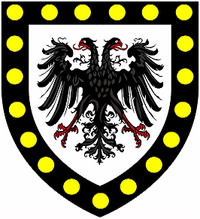Henry Killigrew (playwright)
Dr Henry Killigrew | |
|---|---|
| Born | 11 February 1613 |
| Died | 14 March 1700 (aged 87) England |
| Nationality | British |
| Occupation(s) | Chaplain, almoner, Master of the Savoy |

Dr Henry Killigrew (1613–1700) was the fifth and youngest son of Robert Killigrew and his wife Mary. He was the younger brother of the dramatist Thomas Killigrew, and became chaplain and almoner to the Duke of York, and master of the Savoy after the Restoration.
Life
Henry was born in Hanworth on 11 February 1613, and educated at Cripplegate, London. In 1628, he became a Commoner at Christ Church, Oxford. In 1638, he became MA and was appointed a chaplain in the army shortly afterwards. In November 1642, he became Doctor of Divinity, and subsequently chaplain to James, Duke of York (the future king) and rector of Wheathampstead.
At the Restoration, he was appointed almoner to the Duke of York and the following year Master of the Savoy. A juvenile play of his, The Conspiracy, was printed surreptitiously in 1638, and in an authenticated version in 1653 as Pallantus and Eudora.
Family
He married Judith and had four children:
- Henry Killigrew (died 1712), an admiral
- James Killigrew, also a naval officer, who was killed in an encounter with the French in January 1695 during the Nine Years' War
- Anne Killigrew (1660-1685), poet and painter, who was maid of honour to the Duchess of York, and was the subject of an ode by Dryden, which Samuel Johnson thought the noblest in the language
- Elizabeth Killigrew (died 1701) married her father's curate at Wheathampstead, John Lambe, and produced 10 children
This article incorporates text from a publication now in the public domain: Chisholm, Hugh, ed. (1911). Encyclopædia Britannica (11th ed.). Cambridge University Press. {{cite encyclopedia}}: Missing or empty |title= (help)
References
- Langbaine, Gerard (1691) An Account of the English Dramatick Poets, p. 330
